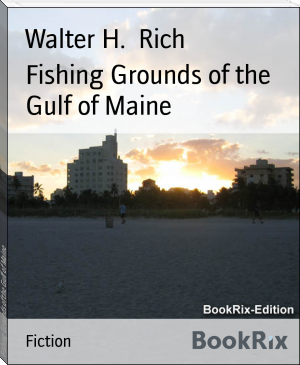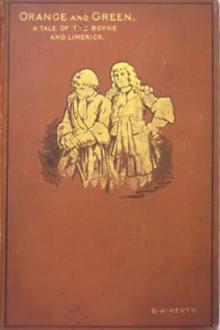Fishing Grounds of the Gulf of Maine, Walter H. Rich [readnow txt] 📗

- Author: Walter H. Rich
Book online «Fishing Grounds of the Gulf of Maine, Walter H. Rich [readnow txt] 📗». Author Walter H. Rich
The outer ridge parallels the inner at about 1½ miles distance and there is a deep, narrow gully between. It apparently has about half the area of the other. This smaller ridge has a 45-fathom shoal of rocks on the western end, deepening the water, like the other, to the eastward to 75 and 80 fathoms over a broken rocky bottom and 90 fathoms on hard mud. This is an all-the-year cusk ground. A few cod are present all the year. but this species is most abundant here and on the other ridge in the spring and through June. Hake occur on the muddy ground in summer and fall.
On both shoals are abundant growths of "lemons" and like species of fish food, and they are good "hand-line spots" over their rocky bottoms. Fishing on both is said to be at its best in the spring and in June, the species taken being cod, cusk, pollock, and hake. As before stated, these are year-around cod and cusk ground, pollock and hake being present in summer and fall, the latter species over the muddy ground. These grounds have been thought to lie too rough for trawling. But occasional good fares are taken on them by this method.
Cashes Bank. Our older reports state that Cashes Bank was not then an important fishing ground except for a short time in the spring, although good fares were often taken there in the fall also. The writer has found it furnishing at least its quota in recent years and in apparently increasing volume. It bears E. 1/4 S. from Cape Ann (Thacher Island Light, from which point most skippers lay their course), from which its shoaler parts are distant 78 miles, and bears SE. 1/4 S. from Portland Lightship 69 miles to the buoy upon it, where is a depth of 17 fathoms; and 74 miles SE. ½ S. from Cape Elizabeth eastern light to the buoy. The bank is about 22 miles long, from 42° 49' to 43° 11' north latitude, and about 17 miles wide, from 68° 40' to 69° 03' west longitude. There are three small shoals upon its western part, of which the southern has a depth of 7 fathoms, the middle one has 4 fathoms, and the northern one has 11 fathoms. The middle shoal lies in 42° 56' north latitude and 68° 52' west longitude. From this the south shoal bears S. by E. and the north shoal NNE., each being 3 1/4 miles distant from it. The water breaks on these in rough weather and, though of small extent, they are dangerous to passing vessels bound from Cape Sable to Massachusetts ports, across whose course they lie directly. Except for these shoals, the water ranges from 15 to 60 fathoms. The ground is more or less broken, and the bottom is of sand, pebbles, and rocks.
The principal fishing on these grounds is for cod, haddock, hake, and cusk; the cod and cusk are present the year around, the cod being most abundant in February, March. and April in an average depth of 60 fathoms. The hake are found on the muddy edges in summer, with a lesser number present all the year. Haddock are present in considerable numbers from November to February, and sometimes a good school occurs in 20-fathom depths in April. The arrival of the dogfish usually puts a temporary ending to the fishing here in the last days of June or early In July, to be resumed again when these pests have moved inshore. Formerly halibut were reported as seen rarely, but of late years they have been found among the kelp in 15 to 18 fathoms on the shoal nearly the year around, the fish ranging in size from 5 to 40 pounds, rarely larger. Halibut of larger size are taken occasionally in fairly good numbers in 30 to 50 fathoms in May and June. Perhaps this species is more abundant on this and neighboring grounds than is generally realized. At all events, certain Portland vessels have recently taken good fares of halibut when fishing for them here in the season named. Cusk are present in the deep water the year around. As is the case with most of the detached ridges in this gulf, the cusk is the most abundant of the fish present about the middle of March. continuing in good numbers through May. In herring years these fish usually occur in good numbers on this ground In late May, and a considerable number of these (food fish or large herring) are taken here by seiners at this season. Mackerel are generally abundant on these grounds In those years when these fish occur In normal quantities on this coast.
Vessels operating on Cashes Bank range in size from 15 to 50 tons, principally from Maine ports, with a fair number of them from Gloucester and Boston, especially in winter. Of late years a few gill-netters have fished here, and these craft are using these grounds in steadily increasing numbers.
A comparatively little known and apparently as yet unnamed ridge lies E. by S. 15 miles from the buoy on Cashes Ledge, which is reported to be good fishing ground, especially for cod and cusk. With both species present here the year around, the cod is said to be most abundant in April and May: and the cusk, as is the rule on these outlying ridges, appears in largest numbers in March and April. Haddock seem to be somewhat rare here.
This ridge lies in a SE. and NW. direction, extending somewhat indefinitely but for at least 10 miles by about 3 miles in width. On the ridge the bottom is broken--a hard bottom of black gravel, which usually means a good fishing spot--the depths here being from 85 to 90 fathoms. There are numerous muddy spots between these harder pieces of ground where soundings run to 100 fathoms or slightly more. The surrounding bottom is mostly of mud, and the depths average from 100 to 125 fathoms. There are a number of pieces of gravelly hard ground in the vicinity, each of which probably would furnish equally good fishing for cod and cusk at the same seasons as on the ridge.
Due E. from the buoy on Ammens Rock about 12 miles lies a ridge that rises from the 100 to 120 fathom depths about it to a depth of about 80 fathoms over a bottom of broken ground, mud, and shells. This shoaler piece is some 3 miles long. N. by E. and S. by NW., by 1 mile wide. It furnishes good fishing for cod, hake, and cusk in the spring, April being the best season.
A ridge lying NW. of Cashes Bank and nearly parallel with the main bank, only separated by a narrow deep channel, is about 7 miles long by 1½ miles wide. The species and the seasons are the same here as on Cashes Bank.
Big Ridge (near Cashes Bank). This is a broken and rocky piece of bottom running from the tip of the southeastern part of the ground, at about 10 miles S. from the buoy on Ammens Rock and about 82 miles SE. ½ S. from the lightship at Portland, to a point about 20 miles S. by E. from the buoy named. Its length is not to be stated definitely, and it is probably greater than here shown. The width averages about 1½ to 2 miles. Depths are from 65 to 80 fathoms and more, increasing gradually as it goes away from the main bank. The species and their seasons of abundance here are as on Cashes Bank. Perhaps this is more of a cod and cusk ground than is the main part of Cashes Bank, the cusk being particularly abundant during March and April. Halibut also are found here in May and June in from 50 to 60 fathoms of water. A considerable amount of the fish shown in the table of the catch from the area included in Cashes Bank may very well have come from this piece of ground.
Another big ridge, paralleling the 100-fathom curve of Georges Bank at about 20 miles N. of it, lies SE by S from the buoy on Cashes Ledge, forty miles to its center; SE by S 110 miles from Portland Lightship; ESE 92 miles from Cape Ann to its western end, and E. by S. ½ S. from the ship at Boston 100 miles. This ridge also is of somewhat indefinite area, being perhaps 20 miles long in an ESE by WNW direction by 1½ to three miles wide. Apparently depths are fairly uniform from 85 to 95 fathoms, the bottom of the ridge being of coarse black sand and having blue mud in the deeper area around it. This is said to be a good cod and cusk ground the year round.
John Dyers Ridge. This lies 14 miles S. by E. from Toothakers Ridge, 40 miles S. by E. from Monhegan Island, and 7 miles NE. from Cashes Bank. It is about 5 miles long by 2 miles wide, lying in an ENE. and WSW. direction. The water is shoalest on the western edge, where are from 45 to 50 fathoms over a sharp, pebbly bottom; thence the ground slopes to the NE. into 75 and 80 fathoms over a hard, gravelly, and muddy bottom, in all other directions falling off sharply to 90 and 100 fathom soundings over a muddy bottom.
This is essentially a cod ground for the entire year, the species being most abundant from May 1 to November. It is a cusk ground all the year on the hard bottom of the deeper parts, March and April showing the largest schools. Hake also are abundant in 70 fathoms and deeper on the mud in summer and fall.
Fifty-five Fathom Bunch. West of Cashes Bank is a rocky ridge extending ENE. and WSW. about 4 miles and having a width of about 1 mile. This is mainly a cod ground, the seasons for the species being as on Cashes Bank.
Fippenies Bank. This consists of two shoals averaging 80 fathoms in depth with a channel of 90 fathoms between them. These run NE. and SW., the eastern shoal about 8 miles long by 1 mile wide, the western about half as large. Fippenies bears E. 1/4 S. from Thacher Island, distant 61 miles; from Portland Lightship, SE. by S. ½ S, 57 miles to the western point of the northern shoal in 35 fathoms. The bank is nearly 10 miles long NE. and SW. and averages 4½ miles wide. The bottom is of gravel, pebbles, and clay, having depths over much of the shoal of about 30 fathoms but also from 36 to 60 fathoms. It is fished by the shore fleet in the spring and early summer. The fish and seasons are as on Cashes Bank. Formerly twice as many haddock were taken here as on Cashes or on Platts Bank, but this has changed in recent years. Halibut are taken here in fair numbers in 45 to 55 fathom depths in June, July, and August on the "black gravel" of the southern and western edge. The "white gravel" on the north shoal is of little account as a fishing ground, since it is composed mostly of the shells of dead scallops.
The Ridge (on the southern part of Fippenies). This is SSE. from the light-ship at Portland 75 miles and has a bottom of yellow mud and pebbles and depths of 75 to 95 fathoms. Cod are present here in December and January; cusk the year around, but most numerous in February and March; haddock in December and January; hake in September and October. The length of this bank is from 4 to 5 miles and the width somewhat less





Comments (0)